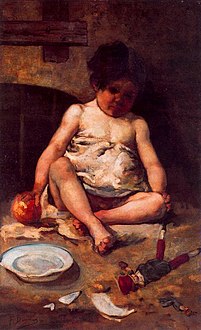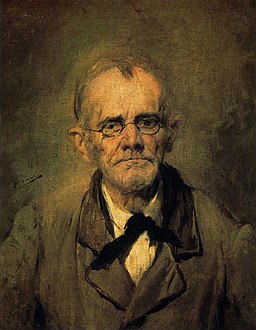Francisco Domingo Marqués

Francisco José Domingo y Marqués (12 March 1842 – 22 July 1920) was a Spanish painter in the
Biography

He was born in
While there, he sent his works to the
He married in 1874 and, the following year, moved to Paris, where his works consisted largely of detailed historical
Benezit Dictionary of Artists His Benezit entry is entered as "Domingo y Marques (Francisco)" The entry shows him winning the Prix de Rome 1867. Professor of The Academy of St Charles, Valencia, 1868. Member of the Academy Royale of Antwerp, 1889. It also records some of his works and sales. The Etienne Haro sales of 1892 and 1897 record the two studies titled a Votre Sante, (see the first A Votre Propre Sante below)[3]
In 1914, at the start of World War I, he returned to Madrid,
Selected paintings
-
Andalusian (1920)
-
Figure of a Child (1887)
-
The Cobbler (1870/75)
-
Doña Carmen Cervera (1870)
-
Santa Clara (1869)
-
A Votre Propre Sante (1876)
References
- ^ a b c Brief biography @ MCN Biografías.
- ^ a b c Brief biography @ the Museo del Prado.
- ^ a b Benezit Dictionary of Artists accessed 2 December 2021.
- ^ Roberto Domingo website.
- ^ Exhibition of Spanish Paintings Royal Academy London November 1920 - January 1921 p 115, accessed 11 August 2023
Further reading
- Francisco Domingo, Valencia, Fundación Bancaja (1998) ISBN 84-89413-42-8
- Carmen Gracia Baneyto, "Francisco Domingo y el mercado de la `High Class Painting'", from Fragmentos, nos.15-16, Madrid (1989)
- Santiago Rodríguez García, El pintor Francisco Domingo Marqués. Resumen de su vida y significación de su obra, Valencia, Círculo de Bellas Artes (1950).
External links
![]() Media related to Francisco Domingo Marqués at Wikimedia Commons
Media related to Francisco Domingo Marqués at Wikimedia Commons






